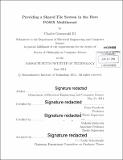| dc.contributor.advisor | Frans Kaashoek and Nickolai Zeldovich. | en_US |
| dc.contributor.author | Gruenwald, Charles, III | en_US |
| dc.contributor.other | Massachusetts Institute of Technology. Department of Electrical Engineering and Computer Science. | en_US |
| dc.date.accessioned | 2014-10-21T17:26:38Z | |
| dc.date.available | 2014-10-21T17:26:38Z | |
| dc.date.copyright | 2014 | en_US |
| dc.date.issued | 2014 | en_US |
| dc.identifier.uri | http://hdl.handle.net/1721.1/91109 | |
| dc.description | Thesis: Ph. D. in Computer Science, Massachusetts Institute of Technology, Department of Electrical Engineering and Computer Science, 2014. | en_US |
| dc.description | 31 | en_US |
| dc.description | Cataloged from PDF version of thesis. | en_US |
| dc.description | Includes bibliographical references (pages 71-73). | en_US |
| dc.description.abstract | Hare is a new multikernel operating system that provides a single system image for multicore processors without cache coherence. Hare allows applications on different cores to share files, directories, file descriptors, sockets, and processes. The main challenge in designing Hare is to support shared abstractions faithfully enough to run applications that run on traditional shared-memory operating systems with few modifications, and to do so while scaling with an increasing number of cores. To achieve this goal, Hare must support shared abstractions (e.g., file descriptors shared between processes) that appear consistent to processes running on any core, but without relying on hardware cache coherence between cores. Moreover, Hare must implement these abstractions in a way that scales (e.g., sharded directories across servers to allow concurrent operations in that directory). Hare achieves this goal through a combination of new protocols (e.g., a 3-phase commit protocol to implement directory operations correctly and scalably) and leveraging properties of non-cache coherent multiprocessors (e.g., atomic low-latency message delivery and shared DRAM). An evaluation on a 40-core machine demonstrates that Hare can run many challenging Linux applications (including a mail server and a Linux kernel build) with minimal or no modifications. The results also show these applications achieve good scalability on Hare, and that Hare's techniques are important to achieving scalability. | en_US |
| dc.description.statementofresponsibility | by Charles Gruenwald, III. | en_US |
| dc.format.extent | 73 pages | en_US |
| dc.language.iso | eng | en_US |
| dc.publisher | Massachusetts Institute of Technology | en_US |
| dc.rights | M.I.T. theses are protected by copyright. They may be viewed from this source for any purpose, but reproduction or distribution in any format is prohibited without written permission. See provided URL for inquiries about permission. | en_US |
| dc.rights.uri | http://dspace.mit.edu/handle/1721.1/7582 | en_US |
| dc.subject | Electrical Engineering and Computer Science. | en_US |
| dc.title | Providing a Shared File System in the Hare POSIX Multikernel | en_US |
| dc.type | Thesis | en_US |
| dc.description.degree | Ph. D. in Computer Science | en_US |
| dc.contributor.department | Massachusetts Institute of Technology. Department of Electrical Engineering and Computer Science | |
| dc.identifier.oclc | 892923488 | en_US |
